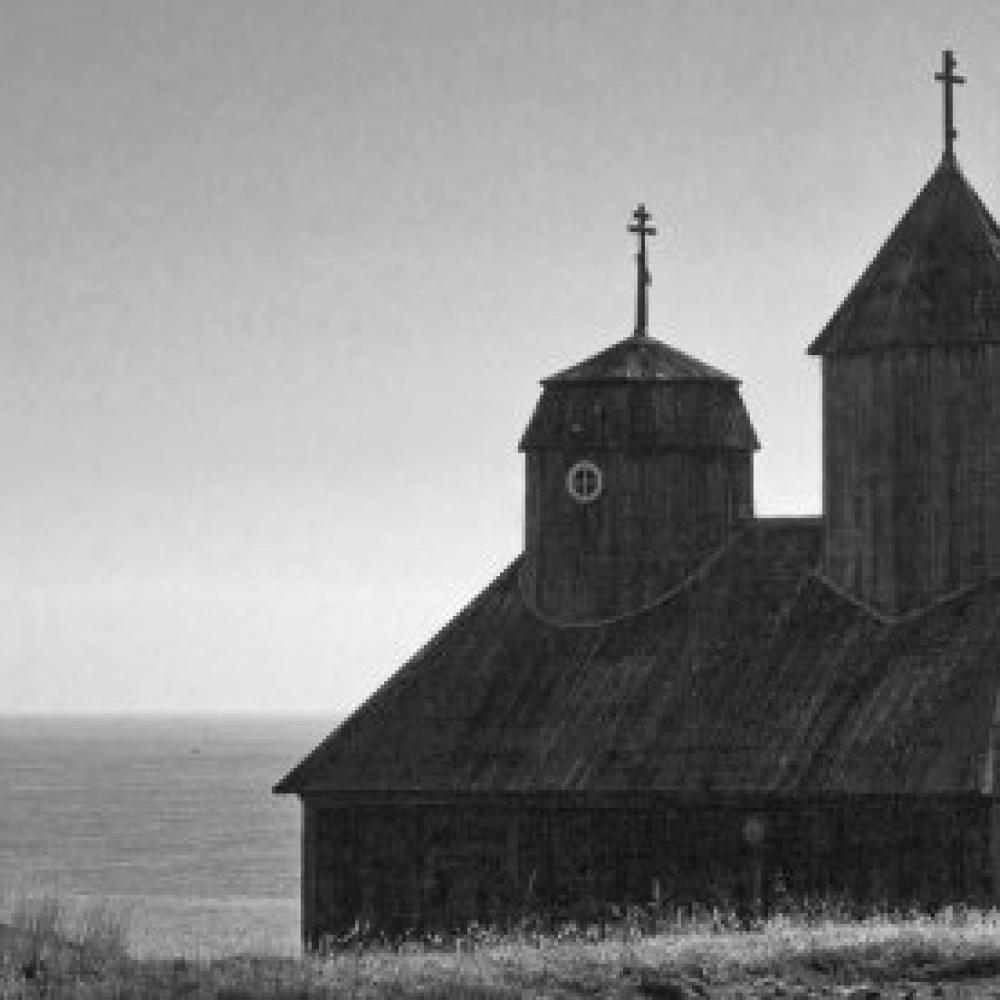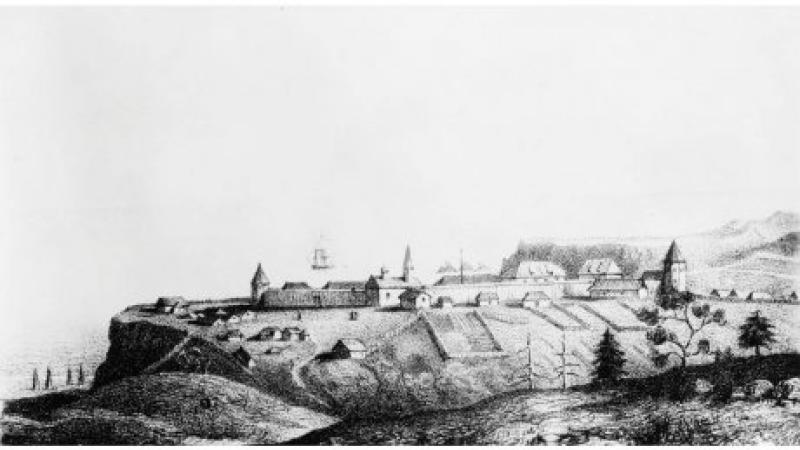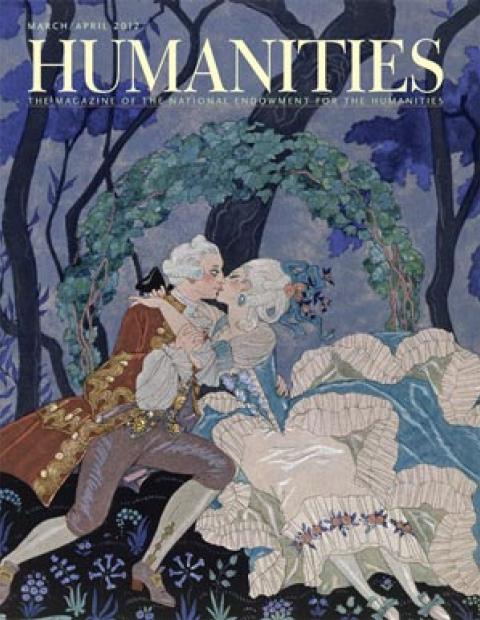North of San Francisco, I am traveling along the isolated Sonoma coast from Bodega Bay to a place the Indians for thousands of years called Metini. Towering stands of redwoods rise up from the insteps of switchbacks on Highway One. The trees go against the grain of steep brown hills, pine-topped ridges, and rugged seaside cliffs. Cows can be heard lowing in the fog-shrouded meadows, while a raucous crowd of barking sea lions cavorts among the boulders cropping out of the foamy surf. A hummingbird halts its flight and holds on to a mid-air perch, while a single-engine plane drones its way up the coast. Delicate ice plants carpet rocky terraces, their yellow and purple blossoms promising more scent than they deliver, while stalky fronds wave menacingly from the hillsides and rills. It’s all, to quote Jack Kerouac, “just too crazy.”
What also piques the curiosity is a fenced-in quadrangle, three hundred feet to a side, set several hundred yards back from the seaside cliffs. Two blockhouses occupy opposing corners and in another is a chapel sporting a dome of sorts. Numerous other wood buildings stand in the compound, which is called Fort Ross. It was built in 1812 by a couple dozen Russians and about eighty Aleuts for the purpose of supplying wheat and furs for the Russian-American Company’s colony in Sitka, Alaska. Only one of the buildings was here at the time of the Russian settlement—the recently restored Rotchev House, once home to Alexander Rotchev, the last of the managers sent by the Russian-American Company.
The entrance to what is now called Fort Ross State Historic Park lies away from the endless expanse of ocean, and you approach Rotchev House on foot by descending through groves of gigantic eucalyptus trees. The Rotchev family lived here from 1838 to 1841. The single-floor dwelling comprises seven rooms and is equipped with a trap door leading to a garret beneath a dramatically hipped roof. The home is sparsely furnished with sturdy, elegant pieces in the Biedermeier style, which was fashionable among Russian aristocrats, especially in the Siberian dwellings of exiled Decembrists. The structure demonstrates several notable Russian building techniques, including the half-dovetail notching of the redwood logs that were used in all the buildings at Fort Ross. The gale-force winds that can hit in winter here just bounce off such solid construction. Additionally, the house is literally a window onto an ingenious Russian method of ventilation: A single windowpane, known as a fortushka, was furnished with hinges and a latch and could swing open by itself, serving as a kind of window within a window.
Inside, one sees further evidence of an unexpectedly civilized life here in this outpost in Alta California, a vast region that was officially claimed by the Spanish but difficult for them to control. In the parlor, the Russians’ refined sensibilities are on full view, with a gleaming samovar and a delicate pianoforte. Rotchev and his wife were book lovers. Both were multilingual; he was also a poet, and she would later translate a children’s book. Researchers are still trying to recreate the selection of books on the shelves, but it is a near certainty that it was once the finest collection in Alta California. One French visitor to the house in Rotchev’s day remarked on the house’s “choice library” and scores by Mozart. He was equally impressed by Rotchev’s wife, Elena, who spoke lively French.
What we know today of Fort Ross in the early and mid nineteenth century comes from research. Archaeologists have examined an Orthodox cemetery on a promontory across a ravine from the fort. The ornamental beads that turned up attested to a diversity of residents and a thriving family life at the fort. The material record also includes crosses, shards of pipes, ceramic cups from China and England, and musket balls, as well as tools and, found in the fort’s boatyard, evidence of work sheds, and banya, or bathhouses. John Sutter, founder of New Helvetia and owner of the mill where gold was discovered in 1848, purchased the fort and all its assets in 1841, and the Russians took their personal belongings with them when they decamped. The picture we have today, then, of this Russian outpost—to say nothing yet of the Creole and Kashaya Indian families living in and around the fort—has come into focus only after decades of work to bring the scattered puzzle pieces back together.
The remote village has proven to have had global connections. Researchers have discovered links between the decorative arts in evidence in Rotchev House and the work of craftsmen as far away as Istanbul. Ceramic pipes that were popular among the Russian aristocracy were created in that era in the Turkish capital. The rugs that the Rotchevs were likely to have had in their home, and reproductions of which lie now in the study and the parlor, would have come from Baluchistan, in present-day Pakistan and Afghanistan. Ancient trade routes and the diplomatic necessities that come with empire-building allowed for such exchange and added yet another cosmopolitan dimension to life at the fort.
Fur trade with China lent a further international aspect to the activities of the Russian-American Company. In the Mongolian town of Kyakhta, Russian traders sold sea otter skins as luxury items. A single skin could fetch the equivalent of a hundred dollars, which, by way of comparison, was what a Pennsylvania farmer might hope to earn in a year in the 1790s. Sea otters were overharvested by 1825, however, which was among the reasons the Russians pulled out of California.
Alexander Rotchev himself was a cosmopolitan. He had been a dashing figure in the literary circles of Moscow, where he worked as a journalist and translator. He met and fell in love with the highly cultivated Elena Gagarina, and, against her family’s wishes, they wed. Rotchev was considered by Elena’s family to be beneath her social standing. Once the couple eloped, Elena was disinherited. The newlyweds moved to St. Petersburg, where Rotchev supported Elena and their new son while working for the Imperial St. Petersburg Theaters. He also translated Molière, Schiller, and Shakespeare for the Russian stage.
Rotchev needed greater income to support his wife and growing family. The Russian-American Company, headquartered in St. Petersburg, opened its doors to him and he strode in. After a year of working at the company’s offices in St. Petersburg, Rotchev was appointed commissioner-at-large and traveled along the Pacific coast of North America as well as to India and China.
Following the explorations of the North Pacific by Vitus Bering, at the encouragement of Peter the Great, the Russian-American Company was founded in 1799 to supply skins for the fur trade. Their primary goal was to increase commerce, but the scientific mission of advancing knowledge was inseparable from early Russian activity in the North Pacific. The company’s main base in Rotchev’s day was in Sitka, Alaska. Owned in large part by the aristocracy, the company had ties to the tsar’s family, and the tsar himself held stock in the company.
While the Russians at Fort Ross were engaged in toolmaking and shipbuilding, as well as defense of the compound, the People from the Top of the Land, the Kashaya, more than lent a hand to the agricultural work there. As the Aleuts were in Alaska, the Kashaya were coerced and cajoled to do the Russians’ bidding. One governor of Russian-America, however, Baron Ferdinand Petrovich von Wrangell, saw the value of treating the native people fairly and judging them on their own terms. The Kashaya benefitted from the Russians’ relatively progressive colonial attitudes and were relieved that the “Undersea People” didn’t force their Orthodox religious views on them. They were also grateful for the Russians’ muskets and cannons, which protected them from the Spanish and Mexicans and other, more aggressive, native peoples.
The ethnographic accounts of Georg von Langsdorff constitute a major resource for understanding the native coastal peoples. As a translator for the Russian-American Company who sailed to San Francisco in 1806 to explore trade possibilities with the Spanish commandant, he provided the earliest portraits of early native life. Ilya Voznesensky later recorded the flora and fauna of coastal Alta California for the Imperial Academy of Sciences. This burst of scientific and cultural inquiry was sparked originally by Peter the Great in the early eighteenth century and continued by Catherine the Great, in her effort to bring “to perfection” knowledge of the North Pacific.
Why the Russians ever left such a splendid ecosystem along California’s coast can be explained to a large extent by why they came in the first place. In coming to Alaska, the Russians abandoned many comforts and seeming necessities, but one they couldn’t break with definitively was bread. So, when exploratory voyages happened upon a pair of coves well to the north of Bodega Bay—a major port north of San Francisco—company officials envisioned a secondary settlement, one that could supply furs to the company but also grow wheat and provide flour for Sitka and other Russian settlements in Alaska.
California’s first windmill was thus constructed at what became Fort Ross, and several ranches were established well away from the protective shadow of the fort, including at least one along the meandering Russian River, which lazily enters the Pacific near today’s picturesque and tiny community of Jenner (“pop. 107,” according to a signpost). “It was an error in judgment,” says Susanna Barlow with the Fort Ross Interpretive Association. “The marine climate wasn’t good . . . for growing a lot of wheat.”
By the time Alexander Rotchev arrived in 1838, the sea otter population had long been seriously diminished, in spite of the company’s moratorium on hunting any sea mammals at all. Additionally, the Kashaya people were more accustomed to a seasonal form of food-gathering, planting, and cultivation that was at odds with the industrial-strength harvest required by the Russians. And while Fort Ross itself was impregnable (it had more than forty cannons aimed at any approach from the sea, and an inland attack in such remote and unforgivable terrain was unthinkable), any attempt by the Russians to colonize inland would have been resisted by the Spanish and Mexicans.
Alta California was administered at the time of Rotchev’s arrival by Mexico. After the Mexican government won independence from Spain, it sought diplomatic recognition and made that a condition for granting Russians the permission to stay. The tsar declined and ordered the company to depart from California.
Rotchev looked upon the Russian settlement in California very fondly and was opposed to the withdrawal, but he did his duty and continued to try to find a buyer for Fort Ross, first among the French, then among the American settlers. Enter John Sutter, who, it is no exaggeration to say, bought the place lock, stock, and barrel in 1841.
Russian contributions to California history are few but significant. In addition to building and using the first windmills, they built the first ships and manufactured tools and equipment for settlers. They also planted orchards from saplings they had brought with them from Russia, possibly even introducing a new apple to North America—although it is in doubt which one. You can walk through the orchards just to the north of Fort Ross and stand next to trees planted by the Russian settlers. Generations of American ranchers have cared for the few remnants of Russian civilization left behind at Fort Ross.
Those groves of eucalyptus trees near the fort, though, were not planted by the Russians. They came later, the result of another wave of California dreamers who thought the species of eucalyptus they planted would provide excellent lumber. Just like the Russian dream of cultivating great quantities of wheat along the northern coast, the decision to plant those eucalyptus trees proceeded from an error in judgment—a rather poetic error, but an error nonetheless.
On leaving the fort, I walk along an old battered former section of Coast Highway One that used to cut straight across Fort Ross’s front yard in Jack Kerouac’s day. Its yellow centerline is still faintly visible. Standing there I revel in the beatific experience of just being here, on the road, in such an exquisite place that works on the imagination and expands one’s sense of the possible.




